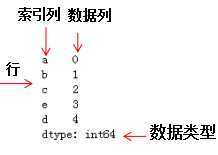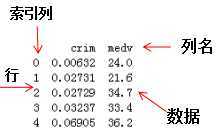参考文章:https://cloud.tencent.com/developer/article/1446127
pandas包含两种数据类型:series和dataframe。
series结构名称:

dataframe是一种二维数据结构,数据以表格形式(与excel类似)存储,有对应的行和列。dataframe结构名称:

mylist = list(‘abcedfghijklmnopqrstuvwxyz‘) # 列表 myarr = np.arange(26) # 数组 mydict = dict(zip(mylist, myarr)) # 字典 # 构建方法 ser1 = pd.Series(mylist) ser2 = pd.Series(myarr) ser3 = pd.Series(mydict) print(ser3.head()) # 打印前5个数据 #> a 0 b 1 c 2 d 4 e 3 dtype:int64
mylist = list(‘abcedfghijklmnopqrstuvwxyz‘) myarr = np.arange(26) mydict = dict(zip(mylist, myarr)) ser = pd.Series(mydict) # series转换为dataframe df = ser.to_frame() # 索引列转换为dataframe的列 df.reset_index(inplace=True) print(df.head()) #> index 0 0 a 0 1 b 1 2 c 2 3 e 3 4 d 4
# 构建series1 ser1 = pd.Series(list(‘abcedfghijklmnopqrstuvwxyz‘)) # 构建series2 ser2 = pd.Series(np.arange(26)) # 方法1,axis=1表示列拼接,0表示行拼接 df = pd.concat([ser1, ser2], axis=1) # 与方法1相比,方法2设置了列名 df = pd.DataFrame({‘col1‘: ser1, ‘col2‘: ser2}) print(df.head()) #> col1 col2 0 a 0 1 b 1 2 c 2 3 e 3 4 d 4
ser = pd.Series(list(‘abcedfghijklmnopqrstuvwxyz‘)) # 命名索引列名称 ser.name = ‘alphabets‘ # 显示前5行数据 ser.head() #> 0 a 1 b 2 c 3 e 4 d Name: alphabets, dtype: object
ser1 = pd.Series([1, 2, 3, 4, 5]) ser2 = pd.Series([4, 5, 6, 7, 8]) # 返回ser1不包含ser2的布尔型series ser3=~ser1.isin(ser2) # 获取ser不包含ser2的元素 ser1[ser3] #> 0 1 1 2 2 3 dtype: int64
ser1 = pd.Series([1, 2, 3, 4, 5]) ser2 = pd.Series([4, 5, 6, 7, 8]) # 求ser1和ser2的并集 ser_u = pd.Series(np.union1d(ser1, ser2)) # 求ser1和ser2的交集 ser_i = pd.Series(np.intersect1d(ser1, ser2)) # ser_i在ser_u的补集就是ser1和ser2不相同的项 ser_u[~ser_u.isin(ser_i)] #> 0 1 1 2 2 3 5 6 6 7 7 8 dtype: int64
# 设置随机数种子 state = np.random.RandomState(100) # 从均值为5标准差为25的正态分布随机抽取5个点构成series ser = pd.Series(state.normal(10, 5, 25)) # 求ser的四分位数 np.percentile(ser, q=[0, 25, 50, 75, 100]) #> array([ 1.25117263, 7.70986507, 10.92259345, 13.36360403, 18.0949083 ])
#从0~7随机抽取30个列表值,组成series ser = pd.Series(np.take(list(‘abcdefgh‘), np.random.randint(8, size=30))) # 对该series进行计数 ser.value_counts() #> d 8 g 6 b 6 a 5 e 2 h 2 f 1 dtype: int64
np.random.RandomState(100) # 从1~4均匀采样12个点组成series ser = pd.Series(np.random.randint(1, 5, [12])) # 除前两行索引对应的值不变,后几行索引对应的值为Other ser[~ser.isin(ser.value_counts().index[:2])] = ‘Other‘ ser #> 0 Other 1 4 2 2 3 2 4 4 5 Other 6 Other 7 Other 8 4 9 4 10 4 11 2 dtype: object
换个角度理解,对数值series离散化成10个类别(categorical)值
ser = pd.Series(np.random.random(20)) # 离散化10个类别值,只显示前5行的数据 pd.qcut(ser, q=[0, .10, .20, .3, .4, .5, .6, .7, .8, .9, 1], labels=[‘1st‘, ‘2nd‘, ‘3rd‘, ‘4th‘, ‘5th‘, ‘6th‘, ‘7th‘, ‘8th‘, ‘9th‘, ‘10th‘]).head() #> 0 3rd 1 1st 2 6th 3 6th 4 9th dtype: category Categories (10, object): [1st < 2nd < 3rd < 4th ... 7th < 8th < 9th < 10th]
ser = pd.Series(np.random.randint(1, 10, 35)) # serier类型转换numpy类型,然后重构 df = pd.DataFrame(ser.values.reshape(7,5)) print(df) #> 0 1 2 3 4 0 1 2 1 2 5 1 1 2 4 5 2 2 1 3 3 2 8 3 8 6 4 9 6 4 2 1 1 8 5 5 3 2 8 5 6 6 1 5 5 4 6
ser = pd.Series(np.random.randint(1, 10, 7)) print(ser) # 获取值是3倍数的索引 np.argwhere(ser % 3==0) #> 0 6 1 8 2 6 3 7 4 6 5 2 6 4 dtype: int64 #> array([[0], [2], [4]])
ser = pd.Series(list(‘abcdefghijklmnopqrstuvwxyz‘)) index = [0, 4, 8, 14, 20] # 获取指定索引的元素 ser.take(index) #> 0 a 4 e 8 i 14 o 20 u dtype: object
ser1 = pd.Series(range(5)) ser2 = pd.Series(list(‘abcde‘)) # 垂直拼接 df = pd.concat([ser1, ser2], axis=0) # 水平拼接 df = pd.concat([ser1, ser2], axis=1) print(df) #> 0 1 0 0 a 1 1 b 2 2 c 3 3 d 4 4 e
# ser1必须包含ser2,否则会报错 ser1 = pd.Series([10, 9, 6, 5, 3, 1, 12, 8, 13]) ser2 = pd.Series([1, 3, 10, 13]) # 方法 1 [np.where(i == ser1)[0].tolist()[0] for i in ser2] # 方法 2 [pd.Index(ser1).get_loc(i) for i in ser2] #> [5, 4, 0, 8]
truth = pd.Series(range(10)) pred = pd.Series(range(10)) + np.random.random(10) # 均方差 np.mean((truth-pred)**2) #> 0.25508722434194103
17.如何使series中每个元素的首字母为大写
# series的元素为str类型 ser = pd.Series([‘how‘, ‘to‘, ‘kick‘, ‘ass?‘]) # 方法 1 ser.map(lambda x: x.title()) # 方法 2 ,字符串相加 ser.map(lambda x: x[0].upper() + x[1:]) # 方法 3 pd.Series([i.title() for i in ser]) #> 0 How 1 To 2 Kick 3 Ass? dtype: object
18.如何计算series中每个元素的字符串长度
ser = pd.Series([‘how‘, ‘to‘, ‘kick‘, ‘ass?‘]) # 方法 ser.map(lambda x: len(x)) #> 0 3 1 2 2 4 3 4 dtype: int64
19.如何计算series的一阶导和二阶导
ser = pd.Series([1, 3, 6, 10, 15, 21, 27, 35]) # 求一阶导并转化为列表类型 print(ser.diff().tolist()) # 求二阶导并转化为列表类型 print(ser.diff().diff().tolist()) #> [nan, 2.0, 3.0, 4.0, 5.0, 6.0, 6.0, 8.0] [nan, nan, 1.0, 1.0, 1.0, 1.0, 0.0, 2.0]
20.如何将一系列日期字符串转换为timeseries
ser = pd.Series([‘01 Jan 2010‘, ‘02-02-2011‘, ‘20120303‘, ‘2013/04/04‘, ‘2014-05-05‘, ‘2015-06-06T12:20‘]) pd.to_datetime(ser) #> 0 2010-01-01 00:00:00 1 2011-02-02 00:00:00 2 2012-03-03 00:00:00 3 2013-04-04 00:00:00 4 2014-05-05 00:00:00 5 2015-06-06 12:20:00 dtype: datetime64[ns]
21. 如何从一个series中获取至少包含两个元音的元素
ser = pd.Series([‘Apple‘, ‘Orange‘, ‘Plan‘, ‘Python‘, ‘Money‘]) # 方法 from collections import Counter # Counter是一个类字典类型,键是元素值,值是元素出现的次数,满足条件的元素返回True mask = ser.map(lambda x: sum([Counter(x.lower()).get(i, 0) for i in list(‘aeiou‘)]) >= 2) ser[mask] #> 0 Apple 1 Orange 4 Money dtype: object
22. 如何计算根据另一个series分组后的series均值
fruit = pd.Series(np.random.choice([‘apple‘, ‘banana‘, ‘carrot‘], 10)) weights = pd.Series(np.linspace(1, 10, 10)) # 根据fruit对weight分组 weightsGrouped = weights.groupby(fruit) print(weightsGrouped.indices) # 对分组后series求每个索引的平均值 weightsGrouped.mean() #> {‘apple‘: array([0, 3], dtype=int64), ‘banana‘: array([1, 2, 4, 8], dtype=int64), ‘carrot‘: array([5, 6, 7, 9], dtype=int64)} #> apple 2.50 banana 4.75 carrot 7.75 dtype: float64
23. 如何计算两个series之间的欧氏距离
p = pd.Series([1, 2, 3, 4, 5, 6, 7, 8, 9, 10]) q = pd.Series([10, 9, 8, 7, 6, 5, 4, 3, 2, 1]) # 方法1 sum((p - q)**2)**.5 # 方法2 np.linalg.norm(p-q) #> 18.16590212458495
24. 如何在数值series中找局部最大值
局部最大值对应二阶导局部最小值
ser = pd.Series([2, 10, 3, 4, 9, 10, 2, 7, 3]) # 二阶导 dd = np.diff(np.sign(np.diff(ser))) # 二阶导的最小值对应的值为最大值,返回最大值的索引 peak_locs = np.where(dd == -2)[0] + 1 peak_locs #> array([1, 5, 7], dtype=int64)
25. 如何用最少出现的字符替换空格符
my_str = ‘dbc deb abed gade‘ # 方法 ser = pd.Series(list(‘dbc deb abed gade‘)) # 统计元素的频数 freq = ser.value_counts() print(freq) # 求最小频数的字符 least_freq = freq.dropna().index[-1] # 替换 "".join(ser.replace(‘ ‘, least_freq)) #> d 4 3 b 3 e 3 a 2 c 1 g 1 dtype: int64 #> ‘dbcgdebgabedggade‘
26. 如何计算数值series的自相关系数
ser = pd.Series(np.arange(20) + np.random.normal(1, 10, 20)) # 求series的自相关系数,i为偏移量 autocorrelations = [ser.autocorr(i).round(2) for i in range(11)] print(autocorrelations[1:]) # 选择最大的偏移量 print(‘Lag having highest correlation: ‘, np.argmax(np.abs(autocorrelations[1:]))+1) #> [0.33, 0.41, 0.48, 0.01, 0.21, 0.16, -0.11, 0.05, 0.34, -0.24] #> Lag having highest correlation: 3
27. 如何对series进行算术运算操作
# 如何对series之间进行算法运算 import pandas as pd series1 = pd.Series([3,4,4,4],[‘index1‘,‘index2‘,‘index3‘,‘index4‘]) series2 = pd.Series([2,2,2,2],[‘index1‘,‘index2‘,‘index33‘,‘index44‘]) # 加法 series_add = series1 + series2 print(series_add) # 减法 series_minus = series1 - series2 # series_minus # 乘法 series_multi = series1 * series2 # series_multi # 除法 series_div = series1/series2 series_div
series是基于索引进行算数运算操作的,pandas会根据索引对数据进行运算,若series之间有不同的索引,对应的值就为Nan。结果如下:
#加法: index1 5.0 index2 6.0 index3 NaN index33 NaN index4 NaN index44 NaN dtype: float64 #除法: index1 1.5 index2 2.0 index3 NaN index33 NaN index4 NaN index44 NaN dtype: float64
1. 如何从csv文件只读取前几行的数据
# 只读取前2行和指定列的数据 df = pd.read_csv(‘https://raw.githubusercontent.com/selva86/datasets/master/Cars93_miss.csv‘,nrows=2,usecols=[‘Model‘,‘Length‘]) df #> Model Length 0 Integra 177 1 Legend 195
2. 如何从csv文件中每隔n行来创建dataframe
# 每隔50行读取一行数据 df = pd.read_csv(‘https://raw.githubusercontent.com/selva86/datasets/master/BostonHousing.csv‘, chunksize=50) df2 = pd.DataFrame() for chunk in df: # 获取series df2 = df2.append(chunk.iloc[0,:]) #显示前5行 print(df2.head()) #> crim zn indus chas nox rm age \ 0 0.21977 0.0 6.91 0 0.44799999999999995 5.602 62.0 1 0.0686 0.0 2.89 0 0.445 7.416 62.5 2 2.7339700000000002 0.0 19.58 0 0.871 5.597 94.9 3 0.0315 95.0 1.47 0 0.40299999999999997 6.975 15.3 4 0.19072999999999998 22.0 5.86 0 0.431 6.718 17.5 dis rad tax ptratio b lstat medv 0 6.0877 3 233 17.9 396.9 16.2 19.4 1 3.4952 2 276 18.0 396.9 6.19 33.2 2 1.5257 5 403 14.7 351.85 21.45 15.4 3 7.6534 3 402 17.0 396.9 4.56 34.9 4 7.8265 7 330 19.1 393.74 6.56 26.2
3. 如何改变导入csv文件的列值
改变列名‘medv’的值,当列值≤25时,赋值为‘Low’;列值>25时,赋值为‘High’.
# 使用converters参数,改变medv列的值 df = pd.read_csv(‘https://raw.githubusercontent.com/selva86/datasets/master/BostonHousing.csv‘, converters={‘medv‘: lambda x: ‘High‘ if float(x) > 25 else ‘Low‘}) print(df.head()) #> b lstat medv 0 396.90 4.98 Low 1 396.90 9.14 Low 2 392.83 4.03 High 3 394.63 2.94 High 4 396.90 5.33 High
4. 如何从csv文件导入指定的列
# 导入指定的列:crim和medv df = pd.read_csv(‘https://raw.githubusercontent.com/selva86/datasets/master/BostonHousing.csv‘, usecols=[‘crim‘, ‘medv‘]) # 打印前四行dataframe信息 print(df.head()) #> crim medv 0 0.00632 24.0 1 0.02731 21.6 2 0.02729 34.7 3 0.03237 33.4 4 0.06905 36.2
5. 如何得到dataframe的行,列,每一列的类型和相应的描述统计信息
df = pd.read_csv(‘https://raw.githubusercontent.com/selva86/datasets/master/Cars93_miss.csv‘) # 打印dataframe的行和列 print(df.shape) # 打印dataframe每列元素的类型显示前5行 print(df.dtypes.head()) # 统计各类型的数目,方法1 print(df.get_dtype_counts()) # 统计各类型的数目,方法2 # print(df.dtypes.value_counts()) # 描述每列的统计信息,如std,四分位数等 df_stats = df.describe() # dataframe转化数组 df_arr = df.values
#修改列名
df.rename(columns={0:‘price‘},inplace=True) # 数组转化为列表 df_list = df.values.tolist() #> (93, 27) Manufacturer object Model object Type object Min.Price float64 Price float64 dtype: object float64 18 object 9 dtype: int64
6. 如何获取给定条件的行和列
import numpy as np df = pd.read_csv(‘https://raw.githubusercontent.com/selva86/datasets/master/Cars93_miss.csv‘) # print(df) # 获取最大值的行和列 row, col = np.where(df.values == np.max(df.Price)) # 行和列获取最大值 print(df.iat[row[0], col[0]]) df.iloc[row[0], col[0]] # 行索引和列名获取最大值 df.at[row[0], ‘Price‘] df.get_value(row[0], ‘Price‘) #> 61.9
7. 如何重命名dataframe的特定列
df1 = pd.DataFrame(data=np.array([[18,50],[19,51],[20,55]]),index=[‘man1‘,‘man2‘,‘man3‘],columns=[‘age‘,‘weight‘]) print(df1) # 修改列名 print("\nchange columns :\n") #方法1 df1.rename(columns={‘weight‘:‘stress‘}) #方法2 df1.columns.values[1] = ‘stress‘ print(df1) #> age weight man1 18 50 man2 19 51 man3 20 55 change columns : age stress man1 18 50 man2 19 51 man3 20 55
8. 如何检查dataframe中是否有缺失值
df = pd.read_csv(‘https://raw.githubusercontent.com/selva86/datasets/master/Cars93_miss.csv‘) # 若有缺失值,则为Ture df.isnull().values.any() #> True
9. 如何统计dataframe的每列中缺失值的个数
df = pd.read_csv(‘https://raw.githubusercontent.com/selva86/datasets/master/Cars93_miss.csv‘) # 获取每列的缺失值个数 n_missings_each_col = df.apply(lambda x: x.isnull().sum()) print(n_missings_each_col.head()) #> Manufacturer 4 Model 1 Type 3 Min.Price 7 Price 2 dtype: int64
10. 如何用平均值替换相应列的缺失值
df = pd.read_csv(‘https://raw.githubusercontent.com/selva86/datasets/master/Cars93_miss.csv‘,nrows=10) print(df[[‘Min.Price‘,‘Max.Price‘]].head()) # 平均值替换缺失值 df_out = df[[‘Min.Price‘, ‘Max.Price‘]] = df[[‘Min.Price‘, ‘Max.Price‘]].apply(lambda x: x.fillna(x.mean())) print(df_out.head()) #> Min.Price Max.Price 0 12.9 18.8 1 29.2 38.7 2 25.9 32.3 3 NaN 44.6 4 NaN NaN #> Min.Price Max.Price 0 12.9 18.8 1 29.2 38.7 2 25.9 32.3 3 23.0 44.6 4 23.0 29.9
11. 如何用全局变量作为apply函数的附加参数处理指定的列
df = pd.read_csv(‘https://raw.githubusercontent.com/selva86/datasets/master/Cars93_miss.csv‘) print(df[[‘Min.Price‘, ‘Max.Price‘]].head()) # 全局变量 d = {‘Min.Price‘: np.nanmean, ‘Max.Price‘: np.nanmedian} # 列名Min.Price的缺失值用平均值代替,Max.Price的缺失值用中值代替 df[[‘Min.Price‘, ‘Max.Price‘]] = df[[‘Min.Price‘, ‘Max.Price‘]].apply(lambda x, d: x.fillna(d[x.name](x)), args=(d, )) print(df[[‘Min.Price‘, ‘Max.Price‘]].head()) #> Min.Price Max.Price 0 12.9 18.8 1 29.2 38.7 2 25.9 32.3 3 NaN 44.6 4 NaN NaN #> Min.Price Max.Price 0 12.900000 18.80 1 29.200000 38.70 2 25.900000 32.30 3 17.118605 44.60 4 17.118605 19.15
12. 如何以dataframe的形式选择特定的列
df = pd.DataFrame(np.arange(20).reshape(-1, 5), columns=list(‘abcde‘)) # print(df) # 以dataframe的形式选择特定的列 type(df[[‘a‘]]) type(df.loc[:, [‘a‘]]) print(type(df.iloc[:, [0]])) # 以series的形式选择特定的列 type(df.a) type(df[‘a‘]) type(df.loc[:, ‘a‘]) print(type(df.iloc[:, 1])) #> <class ‘pandas.core.frame.DataFrame‘> <class ‘pandas.core.series.Series‘>
13. 如何改变dataframe中的列顺序
df = pd.DataFrame(np.arange(20).reshape(-1, 5), columns=list(‘abcde‘)) print(df) # 交换col1和col2 def switch_columns(df, col1=None, col2=None): colnames = df.columns.tolist() i1, i2 = colnames.index(col1), colnames.index(col2) colnames[i2], colnames[i1] = colnames[i1], colnames[i2] return df[colnames] df1 = switch_columns(df, ‘a‘, ‘c‘) print(df1) #> a b c d e 0 0 1 2 3 4 1 5 6 7 8 9 2 10 11 12 13 14 3 15 16 17 18 19 #> c b a d e 0 2 1 0 3 4 1 7 6 5 8 9 2 12 11 10 13 14 3 17 16 15 18 19
原文:https://www.cnblogs.com/Melissa888/p/13214844.html